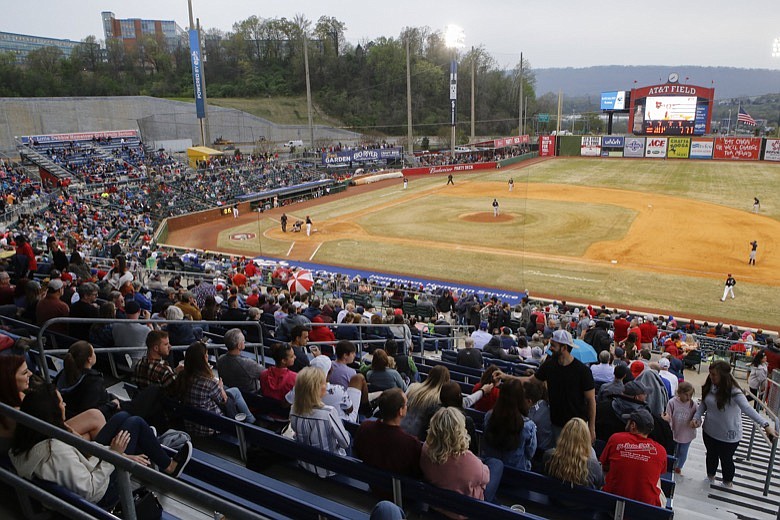Professional baseball's pitchers and catchers began reporting last week. The Atlanta Braves' first preseason game is scheduled for Saturday against the Baltimore Orioles. Our own Chattanooga Lookouts are set to open their regular season at AT&T Field on April 9, against Jackson.
But will it be the last opening day the Lookouts see at AT&T, given they were among 42 teams Major League Baseball targeted for contraction late last year? Is there a path going forward to keep the Lookouts tied to the Cincinnati Reds or some other major league team without building a new stadium? And should that stadium ultimately be constructed, what promise would the Scenic City have that MLB would promise to keep a team there for the next 15 or 20 years?
"We can't think for a minute that they're (MLB) making a threat and they have no intention of making good on that threat," Lookouts co-owner Jason Freier said Monday. "But I am as confident as I can be that an affiliated baseball team will be in Chattanooga well beyond this year."
You hope so. Particularly for small cities such as Chattanooga, a minor league team such as the Class AA Lookouts brings people of all walks of life and economic backgrounds together, provides affordable entertainment for families and can, with the right location, provide an economic boost for roughly six months a year to the area near the ballpark.
No owner understands that more than Freier, whose Hardball Capital ownership group oversaw the building of the $30 million Parkview Field in downtown Fort Wayne, Indiana, a little more than a decade ago. Not only is that ballpark viewed as a Single-A gem with a capacity to hold 8,100 and the ability to host as many as 700 events a year (including the TinCaps' minor league games), but it's also been the hub for the city's mixed-use downtown development project known as Harrison Square.
Do a web search for Harrison Square and you come across a slightly scaled down version of the Battery, the hotel/restaurant/condominium complex built around the Atlanta Braves' new stadium formerly known as SunTrust Park.
Does our city need such a development? And if so, where should it be located? North of the Tennessee River? In the suburbs of Ooltewah, East Brainerd or North Georgia? Somewhere near South Broad Street, which seems to be the current favorite spot to speculate about?
And should such a facility be built, who should pay for it? The community? The owners? Both, the public money coming through the selling of bonds and tax revenue derived from businesses springing up around the stadium rather than the siphoning off of tax revenue better used for schools or infrastructure?
Amazingly, one of the problems for the Lookouts and 41 other minor league franchises is that they don't yet know exactly what they'll be required to do to satisfy MLB's standards for minor league stadiums. New guidelines haven't been drawn up since 1991 but are supposed to be determined by the end of this season.
As Freier pointed out, "In 1991 we didn't even know about having wireless internet available in a stadium. Now it's a must."
But what should be considered a must for young adults attempting to fight their way up the minor league ladder to the major leagues is a different matter. The Reds, for instance, cater three meals a day for the Lookouts to make sure they're eating well. When AT&T Field first opened in 2000, the club had a manager, a pitching coach, a hitting coach and a trainer. Now there's also a bench coach, as well as roving instructors at nearly every game.
Point is, parent clubs are investing more in development every year and therefore apparently expect the minor league clubs to provide more of a big-league atmosphere for their prospects.
Grumpy old men such as myself can argue over the wisdom of making things too nice too soon. The charm of the minor leagues for anyone who's seen the movie "Bull Durham," for instance, is the stories the players share. The endless bus rides. The greasy diners. The fleabag motels. The mold growing in the visitors' locker-room showers.
But one also wonders how much a lot of these future stars deserve much better than that. An old friend who's often visited AT&T Field over the years recently asked me, "Ever seen the Lookouts' dugout after a game? There will be 150 paper cups on the floor, yet there are two big trash cans in there. They don't appreciate what they have now. Why should the Lookouts spend a bunch of money to get them anything nicer?"
Indeed, when the New York Mets recently spent $57 million to renovate their Port St. Lucie, Florida, spring-training facility, they built a separate, more sparse clubhouse for the team's Class A St. Lucie Mets to use during the regular season as opposed to the more opulent clubhouse major and minor leaguers alike would share during spring training.
According to MLB.com writer Anthony DiComo, the Mets' thinking was to, in his words, "give minor leaguers a reminder of the status they're working to earn."
No matter what ultimately happens to our Lookouts, it wouldn't be the worst idea for all of major league baseball to take a similar stance regarding the development of its rising stars.
Contact Mark Wiedmer at mwiedmer@timesfreepress.com.
